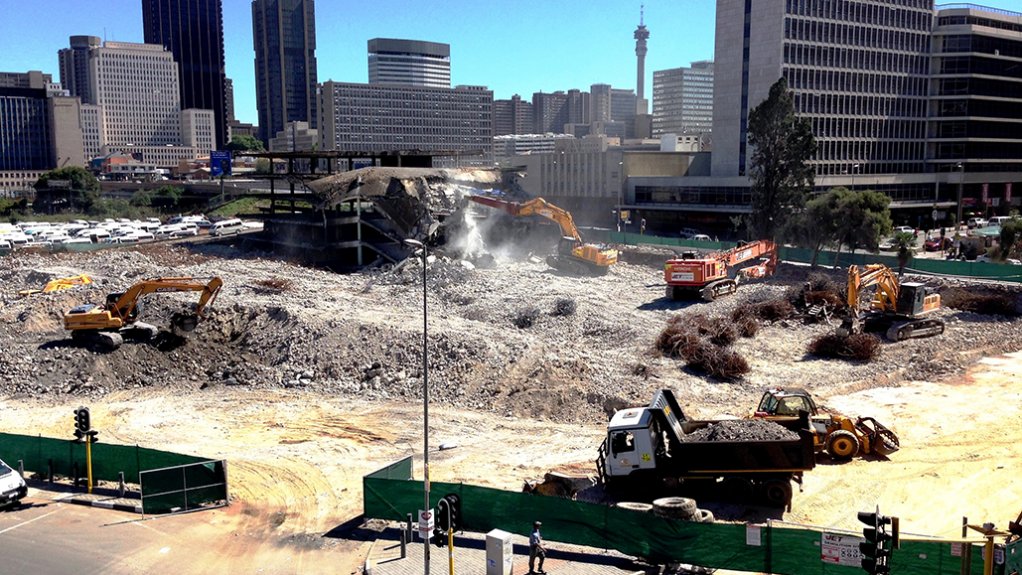Construction rubble is functional, says demolition expert


GETTING IT SORTED The majority of construction materials can be sorted and cleaned mechanically either before or during demolition activities
While a large proportion of demolition and construction rubble is allocated to registered landfill sites, it is critical to note that this material is often used to rehabilitate the landfill sites, says demolition solutions provider Jet Demolition contracts manager Kate Bester.
She explains that the vast majority of registered landfill sites have strict controls over the quality and quantity of material they can accept. This means there is grading and size limitation to the material they accept, with most material being crushed before it is delivered to the landfill sites.
This material is then often used to cap the site or as an engineered fill to serve as a permeable drainage layer.
Reinforcing is generally also removed from the rubble before delivery to landfill and is sent to foundries for recycling, adds Bester.
“If there is material that cannot be suitably downsized and cleaned before disposal, the surcharge on the disposal.”
She explains that this is specifically done to discourage the disposal of material that could otherwise have been recycled.
Waste management is a critical part of any large-scale construction or demolition project and therefore clients, engineers and their contractors must communicate before the start of a project to ensure an alignment of thinking across all spheres, states Bester.
This will ensure a successful cooperative and collaborative approach, with different people actively seeking practical, cost-effective, and responsible solutions to very basic problems, she adds.
Moreover, she notes that when considering material recovery, especially in a large-scale demolition project, it is critical to first consider the risks involved.
The materials recovered can include clean fill, which is a specific type of waste material that can be recycled or reused in future construction projects, as well as metals, paper, cardboard, asphalt shingles, sheet rock, concrete, lumber and other wood waste, glass, electrical wire, plastics and organic materials.
The majority of construction materials can be sorted and cleaned mechanically either before or during demolition activities. Hazardous material abatement is crucial to remove potential risks and contaminants from the structure before demolition.
Jet Demolition will typically abate hazardous materials before demolition where practical, and then move onto the mechanical separation of materials during demolition.
For example, steel will be set aside and processed for delivery to a foundry for recycling; clean demolition rubble will be used as in situ layer works or backfill to voids, where possible; and excess material will be loaded and hauled for reuse, elaborates Bester.
Further, Green Star certifications and similar programmes encourage recycling and the use of sustainable methods and materials, she says.
Unfortunately, the South African construction industry is under enormous pressure owing to reduced margins and rising costs. It is not uncommon that detailed planning is carried out for new construction projects, but that the same level of care is not applied to demolition phases. As such, the expectation is often to conclude demolition quickly and cheaply, without much regard for the end use of demolished materials.
Achieving a fully compliant site is often an ideal that can be achieved only at a significant cost. However, these certifications can be achieved with a well-planned and carefully thought-out approach, Bester points out.
Therefore, it is critical that all role-players are involved from the onset of a project, which can be achieved by determining what the thresholds are, and then seeking alternative solutions that can meet these thresholds while being cost sensitive, Bester explains.
“More often than not, a practical and realistic approach is all that is needed to achieve the end-goals of a fully compliant and ecofriendly project.”
Comments
Press Office
Announcements
What's On
Subscribe to improve your user experience...
Option 1 (equivalent of R125 a month):
Receive a weekly copy of Creamer Media's Engineering News & Mining Weekly magazine
(print copy for those in South Africa and e-magazine for those outside of South Africa)
Receive daily email newsletters
Access to full search results
Access archive of magazine back copies
Access to Projects in Progress
Access to ONE Research Report of your choice in PDF format
Option 2 (equivalent of R375 a month):
All benefits from Option 1
PLUS
Access to Creamer Media's Research Channel Africa for ALL Research Reports, in PDF format, on various industrial and mining sectors
including Electricity; Water; Energy Transition; Hydrogen; Roads, Rail and Ports; Coal; Gold; Platinum; Battery Metals; etc.
Already a subscriber?
Forgotten your password?
Receive weekly copy of Creamer Media's Engineering News & Mining Weekly magazine (print copy for those in South Africa and e-magazine for those outside of South Africa)
➕
Recieve daily email newsletters
➕
Access to full search results
➕
Access archive of magazine back copies
➕
Access to Projects in Progress
➕
Access to ONE Research Report of your choice in PDF format
RESEARCH CHANNEL AFRICA
R4500 (equivalent of R375 a month)
SUBSCRIBEAll benefits from Option 1
➕
Access to Creamer Media's Research Channel Africa for ALL Research Reports on various industrial and mining sectors, in PDF format, including on:
Electricity
➕
Water
➕
Energy Transition
➕
Hydrogen
➕
Roads, Rail and Ports
➕
Coal
➕
Gold
➕
Platinum
➕
Battery Metals
➕
etc.
Receive all benefits from Option 1 or Option 2 delivered to numerous people at your company
➕
Multiple User names and Passwords for simultaneous log-ins
➕
Intranet integration access to all in your organisation



















